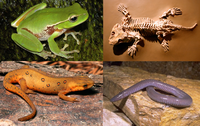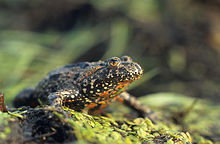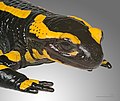Introduction
Selected amphibian type
Toad is a common name for certain frogs, especially of the family Bufonidae, that are characterized by dry, leathery skin, short legs, and large bumps covering the parotoid glands.
A distinction between frogs and toads is not made in scientific taxonomy, but is common in popular culture (folk taxonomy), in which toads are associated with drier, rougher skin and more terrestrial habitats. (Full article...)
Selected frog article
Hyloidea is a superfamily of frogs. Hyloidea accounts for 54% of all living anuran species. The superfamily Hyloidea branched off from its closest relative, the Australobatrachia, during the mid-Cretaceous. The fossil evidence found during the Cretaceous-Paleogene extinction event could not determine the effects upon the frogs, due to the lack of fossils. Increased forestation erupted after this extinction, possibly leading to more arboreal adaptations of these anurans to be best suited for this habitat. (Full article...)
Selected salamander article

The greater siren (Siren lacertina) is an amphibian and one of the three members of the genus Siren. The largest of the sirens and one of the largest amphibians in North America, the greater siren resides in the coastal plains of the southeastern United States. (Full article...)
The page "User:The Transhumanist/Sandbox144/box-header" does not exist. The page "User:The Transhumanist/Sandbox144/DYK/23" does not exist.
Picture slideshow
Selected toad article
Nectophrynoides wendyae, also known as the Uzungwe Scarp tree toad or Wendy's forest toad, is a terrestrial toad in the family Bufonidae. It is endemic to Tanzania and is only known from a single valley in the Udzungwa Mountains. The specific name wendyae honours Wendy Clarke, the describer's wife. (Full article...)
Selected caecilian article
Oscaecilia is a genus of caecilians in the family Caeciliidae. The genus is distributed in southeastern Central America (Costa Rica, Panama) and northern South America, possibly extending into southern Brazil. They are sometimes known as the South American caecilians. (Full article...)
Categories
Topics
Related portals
Associated Wikimedia
The following Wikimedia Foundation sister projects provide more on this subject:
-
Commons
Free media repository -
Wikibooks
Free textbooks and manuals -
Wikidata
Free knowledge base -
Wikinews
Free-content news -
Wikiquote
Collection of quotations -
Wikisource
Free-content library -
Wikiversity
Free learning tools -
Wiktionary
Dictionary and thesaurus
























































